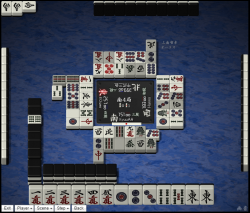Gyakuten

Gyakuten 「逆転」 ("comeback") is when a player improves their placement during the last hand.
Knowledge of the points table is particularly helpful for pulling a comeback: it can help determine the needed tile composition, if you can open the hand, if you need to call riichi, and other key decisions. In any case, like most things in Mahjong, at least a little luck is required to win.
Strategy for oorasu
The term "gyakuten" normally applies to the last hand of the game. In the last round, once a non-dealer wins, the game ends, and placement is finalized. Therefore, even a 100 point difference can matter. Lower players must develop a hand that gives enough score to pass the higher ranked players. On the other hand, players with their desired standing must find a way to retain their position at the end of the game, either by winning the final hand or simply avoiding losing points.
Gyakuten is important because placement is itself important. Thanks to oka and/or uma, a player can receive a large bonus for rising up a rank. Conversely, players can lose a lot if they fall in rank. In some types of play, such as certain tournaments or tenhou.net's dan ranking, final placement is the only thing that matters.
Riichi
If an open version of a hand is enough to improve your placement, no matter how it's won, then open the hand for the extra speed. Similarly, if you can guarantee improvement with a damaten hand, then do that.
Riichi gives 1 han, plus random bonuses via ippatsu, ura dora, and/or mentsumo. If you're particularly lucky, a riichi-only hand can turn into 7900 points with riichi ippatsu mentsumo dora 1. You should try to guarantee a comeback without any bonus han. However, if you have no reasonable way to do so, go for a riichi and hope you get enough points. At the same time, opponents will be especially wary of a riichi in the last round, precisely because they don't want to lower their placement.
In some cases, the 1000 point riichi bet is enough to drop you down a placement. If you have another yaku, you should usually go dama. If you don't have a yaku, then riichi is still worthwhile if you have a good wait. Since the trailing player is only 1000 points behind, any win they make would be enough for you to drop down, so you should still try to win.
Score differences
In the last hand of the game, non-dealers will likely have only one chance to make a difference, so awareness of the point differences and the scoring table are key.
The following table displays the minimum han/fu value required to surpass a leading player at a given point spread. Note that as you take points from everyone when you tsumo, the required han/fu value for tsumo is lower than a non-direct hit ron.
| Han-Fu | Non-dealer | Dealer | |||
|---|---|---|---|---|---|
| Tsumo | Ron | Tsumo | Ron | ||
| Non-dealer diff | Dealer diff | ||||
| 1-30 | 1400 | 1600 | 2000 | 2000 | 3000 |
| 1-40 & 2-20 | 1900 | 2000 | 2600 | 2800 | 4000 |
| 1-50 & 2-25 | 2000 | 2400 | 3200 | 3200 | 4800 |
| 1-60 & 2-30 | 2500 | 3000 | 4000 | 4000 | 5800 |
| 1-70 | 3000 | 3600 | 4600 | 4800 | 6800 |
| 1-80 & 2-40 & 3-20 | 3400 | 4000 | 5200 | 5200 | 7800 |
| 2-50 & 3-25 | 4000 | 4800 | 6400 | 6400 | 9600 |
| 2-60 & 3-30 | 5000 | 6000 | 7800 | 8000 | 11600 |
| 2-70 | 5900 | 7000 | 9000 | 9200 | 13600 |
| 2-80 & 3-40 & 4-20 | 6500 | 7800 | 10400 | 10400 | 15400 |
| 3-50 & 4-25 | 8000 | 9600 | 12800 | 12800 | 19200 |
| 3-60 & 4-30 | 9900 | 11800 | 15400 | 15600 | 23200 |
| Mangan | 10000 | 12000 | 16000 | 16000 | 24000 |
| Haneman | 15000 | 18000 | 24000 | 24000 | 36000 |
| Baiman | 20000 | 24000 | 32000 | 32000 | 48000 |
| Sanbaiman | 30000 | 36000 | 48000 | 48000 | 72000 |
| Yakuman | 40000 | 48000 | 64000 | 64000 | 96000 |
Note: direct hit rons are worth double. Also, make sure to apply honba and/or riichi bets as needed.
External links
| |||||||||||